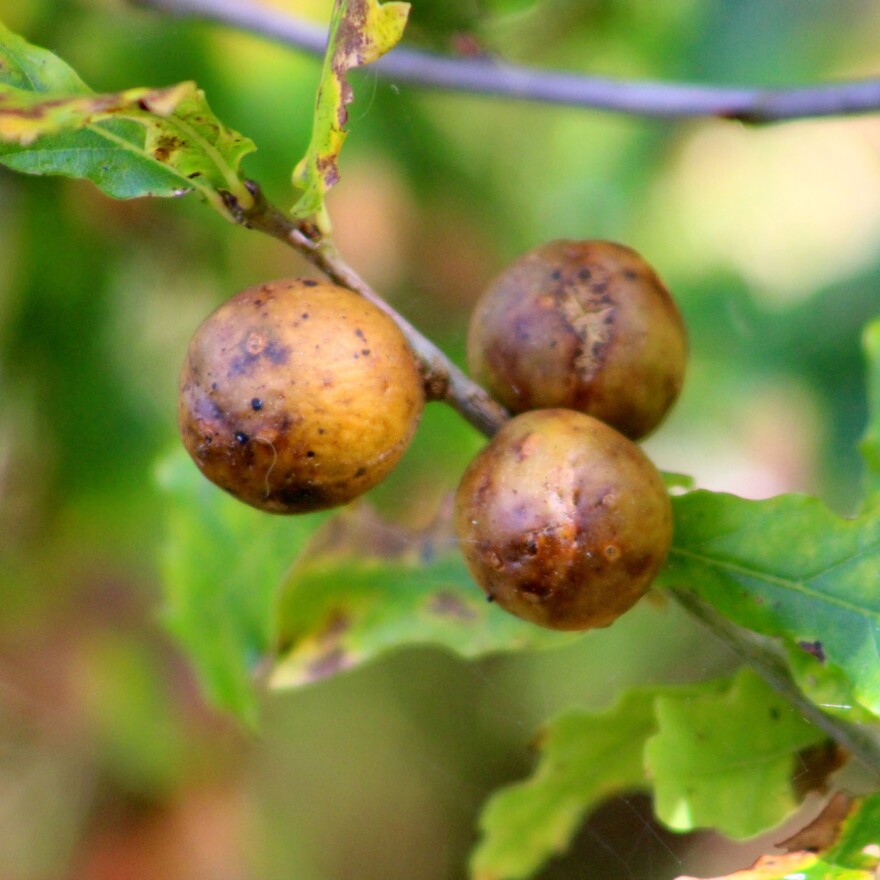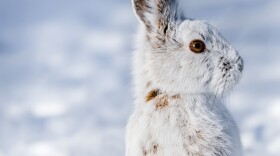Field Notes: The Role of Oak Galls in Shakespeare’s Plays
Lavonne Rus-Ogilvie
It’s time for Field Notes, brought to you by the Montana Natural History Center.
In April, the boulevard bur oaks are hard to love. Hard, gnarly clusters cover their dark empty branches. If I pay any attention at all to these scary silhouettes, it’s with a wish that they would leaf out: one, to improve their appearance, and two, to convince me they are still alive. But mostly I pass them by.
Today, I pause. I move in and circle around for a closer look. I gently bend a branch to inspect those knobby clusters. Amazing! There must be hundreds on this one tree alone: small wooden balls with a pin-hole dot. Some are old, dark, and dry, and others a smooth, chestnut brown. Grown from the woody branches, they range in size between a malted-milk ball and a large grape. They crowd together and overlap in intricate bundles.
What drove me to have a closer look at these strange formations? It was a line in a book. By Any Other Name, a novel by Jodi Picoult, explores the possibility that a woman may have secretly written some of Shakespeare’s plays. In the book, the character dips her feather quill into oak gall ink. “What?” I wondered. I needed to know more.
Turns out, galls (or gall nuts) are common on bur oak, Montana’s only native oak tree. These are slow-growing trees and can live up to 200-300 years.
Galls are weird growths that trees produce when something bugs them. In this case, it’s an actual bug–the oak rough bulletgall wasp. When it lays its egg under the tree bark, a process is set off and the tree begins to grow woody tissue, fully surrounding the gallmaker.
We start to see oak galls mid summer, and each one houses only a single wasp larva. In the fall, after metamorphosis, a self-fertile adult female burrows her way out and lays eggs on future oak leaf buds. When spring arrives, both female and male wasps emerge. They mate, and the females lay their eggs in the fresh branches. And the cycle begins all over again with the tiny larva developing inside the gall until its fall debut.
Bullet galls can remain on a host tree for as many as five years after the gall-maker has left. While they can reduce the growth rate of a host tree, current thinking is galls do not kill the branches. These galls also secrete a sticky honeydew substance that attracts wasps, bees, and ants. These insects feed on the sticky sweetness and protect the gallmaker from its natural enemy–parasitic wasps. These honeydew-covered condos are also rich in tannic acid—and this brings us back to oak gall ink. Tannic acid provides a source of color, turning black when mixed with iron sulfate, and many types of oak galls can be used to make ink.
Oak gall ink was the most popular ink in Europe from the Middle Ages to the 19th century. The Book of Kells from A.D. 800, the Magna Carta, and the Declaration of Independence were all written in gall ink. And while we’re not sure if a woman did write some of Shakespeare’s plays, they were written in that special combination of iron sulfate, water, gum Arabic, and gall nuts.
It took a line in a book to draw me to these oak trees—and they are easier to love now that I know their historical role in putting ink on the page.
Today’s Field Note was written as part of the Montana Master Naturalist Class through Sacajawea Audubon. I’m Lavonne Rus-Ogilvie for Field Notes, brought to you by the Montana Natural History Center, providing natural history education for schools and the public throughout Montana. For more information about upcoming events and programs at the Center, call 406.327.0405 or visit our website at MontanaNaturalist.org.
References
Centerville Washington Park District & Goldstein, D. L. (2024, September 1). Oaks and Wasps:
One Picture, So Many Questions. Centerville Washington Park District. Retrieved April 30, 2025, from
Hoover, G. A. (2023, June 19). Galls on Oak. Penn State Extension. Retrieved May 12, 2025, from
https://extension.psu.edu/galls-on-oak
McFarling, U. L. (2019, May 1). Making Ink from Oak Galls. The Huntington Library. Retrieved
May 12, 2025, from https://www.huntington.org/verso/making-ink-oak-galls
Roy, N. (2024, August 21). Make Ancient Ink with the Help of Parasites. Science Friday.
Retrieved May 11, 2025, from https://www.sciencefriday.com/educational-
resources/make-ancient-ink/
Shour, M. (2004, May 17). The Inside Story of Common Gall on Oaks. Iowa State University
Extension News. Retrieved April 18, 2025, from https://www.extension.iastate.edu/newsrel/2004/may04/may0414.html#





